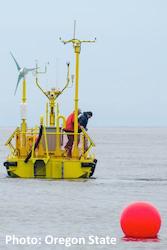According to a new analysis published in the journal Renewable Energy, large-scale wave energy systems developed in the Pacific Northwest should be comparatively steady, dependable and able to be integrated into the overall energy grid at competitive costs to other forms of renewable energy including wind power. The study finds that wave energy has less variability than some other energy sources and that by balancing wave energy production over a large geographic area variability can be further reduced.
Variability of renewable energy production from sources such as solar or wind have been a concern and often require back-up energy sources leading to extra costs. Wave energy may be a more reliable and ultimately less expense option when the technology is future developed.
 “Whenever any new form of energy is added, a challenge is to integrate it into the system along with the other sources,” said Ted Brekken, an associate professor and renewable energy expert in the College of Engineering at Oregon State University.
“Whenever any new form of energy is added, a challenge is to integrate it into the system along with the other sources,” said Ted Brekken, an associate professor and renewable energy expert in the College of Engineering at Oregon State University.
“By producing wave energy from a range of different sites, possibly with different types of technology, and taking advantage of the comparative consistency of the wave resource itself, it appears that wave energy integration should be easier than that of wind energy,” he continued. “The reserve, or backup generation, necessary for wave energy integration should be minimal.”
Today, wave energy is not being commercially produced in the Pacific Northwest, but the researchers expert its future potential is significant, and costs should come down as technologies improve and more systems are developed. In addition, the study suggested, that its short-term generation capacity can be predicted with a high degree of accuracy over a time scale ranging from minutes to hours, and with some accuracy even seasonally or annually.

